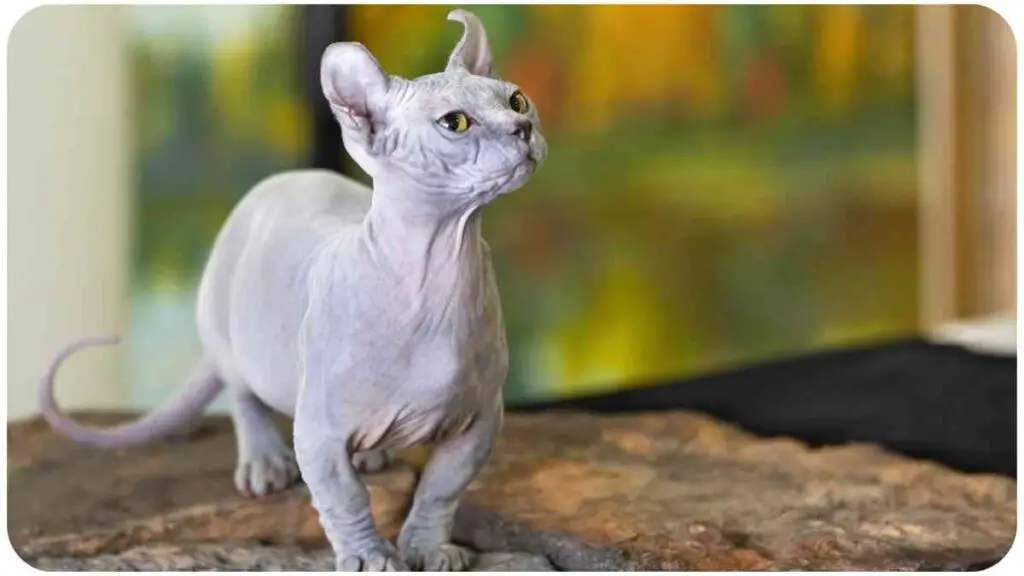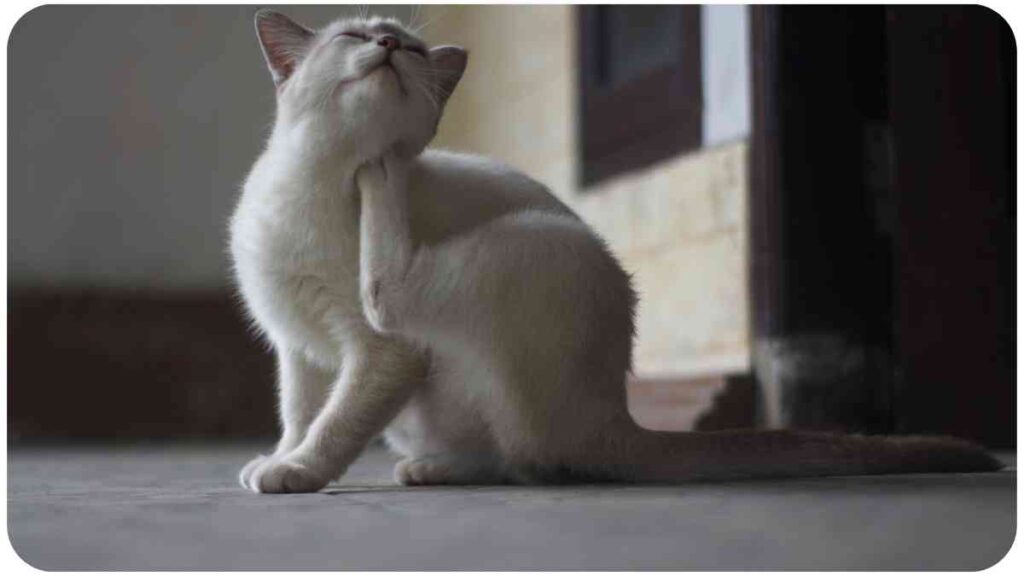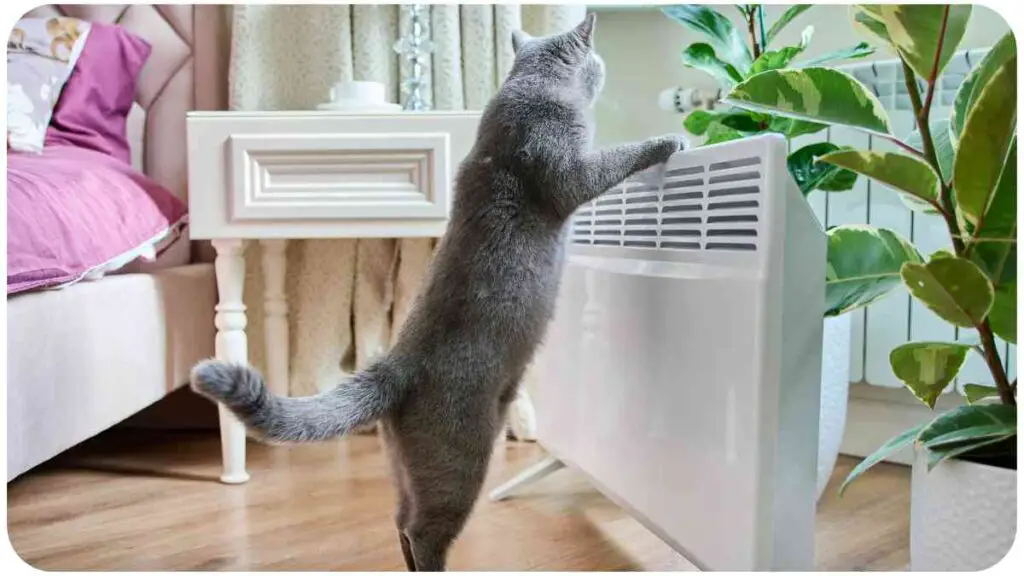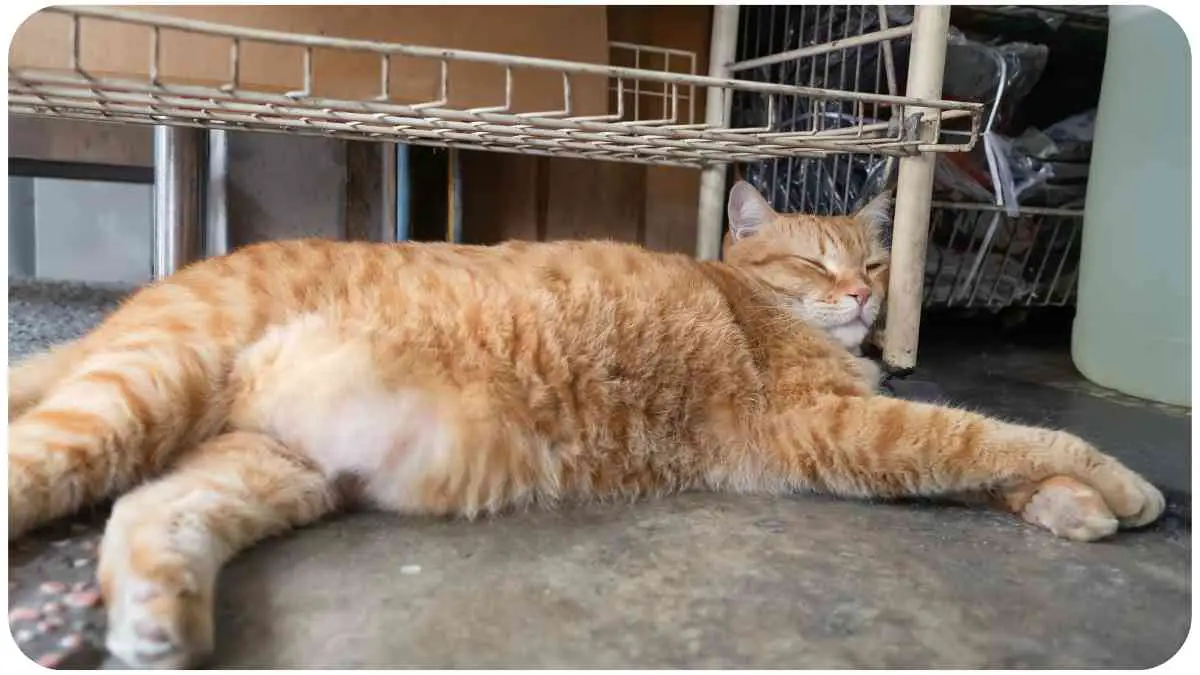Caring for a cat involves understanding its various physiological processes, one of which is the heat cycle. In this comprehensive guide, we will delve into the intricacies of how long a cat stays in heat, providing valuable insights for cat owners and enthusiasts.
| Takeaways |
| Understanding the cat’s heat cycle is crucial for responsible pet ownership. |
| Heat cycles can last 3 to 7 days, occurring every 2 to 3 weeks, unless a cat is spayed or becomes pregnant. |
| Spaying is recommended to prevent continuous heat cycles and unwanted pregnancies. |
| Behavioral changes during heat cycles include vocalizing, increased affection, and restlessness. |
| Cats may go into heat as early as 4 months, emphasizing the importance of early spaying. |
| Environmental factors and breed variations influence the timing and characteristics of heat cycles. |
| Prolonged heat cycles may signal underlying health issues, warranting veterinary attention. |
| Comprehensive cat care goes beyond heat cycles, encompassing nutrition, veterinary check-ups, and stimulation. |
| Embracing feline companionship involves celebrating the bond and fostering a happy and healthy life. |
2. Understanding the Cat Heat Cycle
The cat heat cycle is a complex series of stages, each with distinct characteristics and behaviors. Let’s explore these stages in detail.
Russian Blue Lifespan: Russian Blue cats, known for elegance and grace, typically enjoy a lifespan of 15 years or more. Owners cherish their companionship, as these feline friends bring joy and affection to households.
2.1 Proestrus Stage
The proestrus stage marks the beginning of the heat cycle, lasting one to two days. During this phase, subtle changes may occur, and a cat may attract unneutered male cats without being ready to mate.
| Behavioral Changes | Duration |
| Increased affection | 1-2 days |
| Rubbing head and neck | |
| Attraction to males |
Table 2.1.1: Proestrus Stage Characteristics
C: Continue
2.2 Estrus Stage
The estrus stage, lasting one to two weeks, is when a cat is receptive to mating. This period showcases more noticeable signs, such as vocalization, rolling on the floor, and increased affection towards owners.
| Behavioral Changes | Duration |
| Loud vocalization | 1-2 weeks |
| Rolling on the floor | |
| Increased affection | |
| Crouching with rear end raised |
Table 2.2.1: Estrus Stage Characteristics
2.3 Interestrus Stage
If the cat does not mate during the estrus stage, the interestrus stage follows, lasting between 2-3 weeks. During this period, a cat’s estrogen levels drop, and no sexual behaviors are exhibited. This serves as the in-between phase before the next heat cycle.
Russian Blue Personality: Exploring the enigmatic charm of Russian Blue cats reveals a personality marked by intelligence, gentleness, and a preference for quiet companionship. Cat enthusiasts appreciate these unique traits that make Russian Blues beloved members of the family.
| Behavioral Changes | Duration |
| No sexual behaviors | 2-3 weeks |
| Reproductive rest |
Table 2.3.1: Interestrus Stage Characteristics
2.4 Anestrus Stage
Anestrus is the period of reproductive dormancy, typically occurring in late fall and winter. Outdoor cats are more influenced by natural daylight, while indoor cats may experience year-round heat cycles due to artificial lighting.
| Reproductive Status | Duration |
| Dormancy | Seasonal cycle |
Table 2.4.1: Anestrus Stage Characteristics
2.5 Diestrus Stage
The diestrus stage occurs if a cat becomes pregnant during the estrus stage. It involves the implantation of fertilized eggs in the uterus, with approximately 84% of embryos surviving the process.
| Reproductive Process | Duration |
| Embryo implantation | 12-13 days |
| Survival rate of fertilized eggs | Approximately 84% |
Table 2.5.1: Diestrus Stage Characteristics
3. Signs of a Cat in Heat

Recognizing the signs of a cat in heat is crucial for cat owners. These signs can vary and may include vocalization, behavioral changes, and certain physical cues.
Cat Ear Biting: Have you ever wondered why cats engage in ear-biting behavior? This quirky habit often serves as a form of affection or play. Understanding the reasons behind this behavior enhances the bond between feline companions and their human counterparts.
3.1 Vocalization
One of the initial signs is an increase in vocalization. Cats in heat may cry and meow loudly, attempting to communicate their fertility to other cats.
3.2 Urine Spraying
Cats in heat may engage in urine spraying, a behavior that helps attract male cats. Understanding and managing this behavior is essential for maintaining a clean environment.
3.3 Behavioral Changes
The cat may exhibit demanding behavior, seeking more attention from its owner. Increased affection, rolling on the floor, and rubbing against objects are common behaviors during this time.
3.4 Physical Signs
Physically, a cat in heat may arch its rear end into the air, a gesture signaling receptivity to male cats. Additionally, a loss of appetite might be observed.
| Signs of Heat | Common Behaviors |
| Vocalization | Loud crying and meowing |
| Urine Spraying | Marking territory with hormones |
| Behavioral Changes | Increased demand for attention |
| Rolling, rubbing, and increased affection | |
| Physical Signs | Arching rear end and signaling receptivity |
| Loss of appetite |
Table 3.1: Signs of a Cat in Heat
4. Frequency and Duration of Heat Cycles

Understanding the frequency and duration of cat heat cycles is crucial for cat owners. This information helps in anticipating and managing the behavioral changes associated with a cat in heat.
Dominant Cat Behavior: Navigating dominant and anxious cat behavior requires patience and insight. Discover effective strategies to foster a harmonious relationship with your feline friend. From providing a secure environment to positive reinforcement, these approaches help create a peaceful coexistence.
Cats typically go into heat every 2 to 3 weeks. The duration of a single heat cycle varies, lasting approximately 3 to 7 days. However, for some cats, this cycle may extend up to 20 days.
It’s essential for cat owners to recognize these cycles to provide appropriate care and consider spaying to prevent continuous heat cycles.
| Frequency of Heat Cycles | Duration of a Single Cycle |
| Every 2 to 3 weeks | 3 to 7 days, up to 20 days for some cats |
Table 4.1: Frequency and Duration of Cat Heat Cycles
5. Factors Influencing Cat Heat Cycles
Several factors can influence the timing and characteristics of a cat’s heat cycles. Let’s explore these factors in detail.
5.1 Breed Variations
Different cat breeds may exhibit variations in the onset and duration of heat cycles. Short-haired breeds might start cycling earlier than their long-haired counterparts.
5.2 Environmental Factors
Environmental factors, such as exposure to daylight, play a significant role. Cats typically go into heat when exposed to 14-16 hours of daylight.
5.3 Age of Sexual Maturity
The age at which a cat reaches sexual maturity can impact when it starts going into heat. While the average is 6-9 months, individual cats may vary.
| Factors | Influence on Heat Cycles |
| Breed Variations | Different onset and duration based on the breed |
| Environmental Factors | Daylight exposure affects the timing of heat cycles |
| Age of Sexual Maturity | Individual variations in the onset of heat cycles |
Table 5.1: Factors Influencing Cat Heat Cycles
6. How to Manage a Cat in Heat

Managing a cat in heat involves a combination of understanding their behavior and implementing strategies to make this period more comfortable for both the cat and the owner.
Cat Wheelchair Comfort: Meowingtons Cat Wheelchair ensures optimal comfort for differently-abled feline friends. Learn about the adjustments that cater to individual needs, allowing cats to enjoy mobility and freedom. Owners find solace in providing their cats with a supportive and comfortable mobility solution.
6.1 Play and Affection
Engaging in play and providing extra affection during a cat’s heat cycle can help distract them from hormonal urges. Interactive toys and spending quality time together can be beneficial.
6.2 Keeping Cats Indoors
To prevent mating and unwanted pregnancies, keeping a cat indoors during the heat cycle is advisable. This also minimizes the chances of encountering unneutered male cats.
6.3 Use of Catnip
Catnip can be a useful tool in managing a cat in heat. Many cats are attracted to catnip, and it can serve as a source of entertainment, reducing restlessness.
6.4 Synthetic Cat Pheromones
Using synthetic cat pheromones, available in various products, can help create a calming environment for a cat in heat. These products mimic natural feline facial pheromones.
| Management Strategies | Implementation Tips |
| Play and Affection | Interactive toys, dedicated playtime, and attention |
| Keeping Cats Indoors | Create a secure indoor environment during heat cycles |
| Use of Catnip | Offer catnip-infused toys or sprinkle catnip in the environment |
| Synthetic Cat Pheromones | Utilize pheromone diffusers, sprays, or collars |
Table 6.1: Strategies for Managing a Cat in Heat
7. Spaying a Cat: Timing and Considerations
Spaying is a crucial aspect of cat care that not only prevents unwanted pregnancies but also contributes to a cat’s overall health and well-being.
7.1 Spaying During Heat
While it is possible to spay a cat while she is in heat, veterinarians often recommend waiting until the heat cycle has concluded. This is because the increased blood flow during heat can pose additional challenges during surgery.
7.2 Benefits of Spaying
Spaying offers numerous benefits, including the prevention of heat cycles, reduction in the risk of certain cancers, and avoidance of unwanted litters. It is a responsible decision for cat owners concerned about population control and their cat’s health.
| Spaying Considerations | Timing |
| Spaying During Heat | Possible but often recommended after heat cycle |
| Benefits of Spaying | Prevention of heat cycles, reduced cancer risks, and population control |
Table 7.1: Considerations for Spaying a Cat
8. Personal Experiences with Cats in Heat
As a seasoned professional in the field, I’ve encountered various challenges and successes in managing cats during their heat cycles. Let me share some insights based on personal experiences.
8.1 Challenges Faced
Managing a cat in heat can be challenging, especially when dealing with behavioral changes and the need for constant attention. It requires patience and understanding to create a conducive environment for both the cat and the owner.
8.2 Successful Management Strategies
Implementing a combination of play, affection, and the use of calming products has proven successful in managing cats during heat cycles. Understanding each cat’s unique needs is crucial for devising effective strategies.
| Professional Insights | Challenges Faced |
| Personal Challenges | Behavioral changes, constant attention, and restlessness |
| Successful Strategies | Combination of play, affection, and calming products |
Table 8.1: Personal Experiences with Cat Heat Cycles
9. Expert Tips for Cat Owners
Drawing from my expertise, here are some expert tips for cat owners to navigate and effectively manage their cat’s heat cycles.
9.1 Recognizing Heat Cycles
Understanding the subtle signs and behaviors associated with heat cycles is crucial. Regular observation and noting changes in vocalization, behavior, and physical cues can help cat owners identify when their cat is in heat.
9.2 Importance of Spaying
Spaying is a proactive measure to prevent continuous heat cycles, unwanted pregnancies, and potential health issues. Cat owners should consider spaying as a responsible decision for the overall well-being of their feline companions.
9.3 Creating a Comfortable Environment
During a cat’s heat cycle, providing a secure and comfortable environment is essential. Engage in play, offer affection, and use calming products to ease the restlessness associated with this period.
9.4 Consulting a Veterinarian
Regular consultations with a veterinarian ensure that cat owners receive personalized advice based on their cat’s health, age, and breed. Veterinarians can guide owners in making informed decisions about spaying and managing heat cycles.
| Expert Tips for Cat Owners | Guidance for Cat Care |
| Recognizing Heat Cycles | Observe changes in vocalization, behavior, and physical cues |
| Importance of Spaying | Proactive measure for preventing continuous heat cycles and health issues |
| Creating a Comfortable Environment | Play, affection, and calming products contribute to a serene environment |
| Consulting a Veterinarian | Regular guidance for personalized cat care |
Table 9.1: Expert Tips for Cat Owners
10. The Role of Breed and Environment
Breed and environmental factors play a significant role in shaping a cat’s heat cycles. Understanding how these factors influence timing and characteristics can aid cat owners in providing optimal care.
10.1 Breed Variations
Different cat breeds exhibit variations in the onset and duration of heat cycles. Short-haired breeds may start cycling earlier, while long-haired breeds may show signs later.
10.2 Impact of Environmental Factors
The exposure to daylight is a critical environmental factor affecting a cat’s heat cycles. Cats typically go into heat when exposed to 14-16 hours of daylight, emphasizing the influence of natural and artificial lighting.
| Role of Breed and Environment | Influence on Heat Cycles |
| Breed Variations | Varied onset and duration based on breed |
| Impact of Environmental Factors | Daylight exposure influences the timing of heat cycles |
Table 10.1: Breed and Environmental Influences on Cat Heat Cycles
11. Addressing Prolonged Heat Cycles
In some cases, cat owners may notice prolonged heat cycles, raising concerns. Addressing this issue requires a proactive approach and understanding potential causes.
11.1 Possible Causes of Prolonged Heat
Factors such as underlying health issues, hormonal imbalances, or individual variations can contribute to extended heat cycles. Consulting a veterinarian is essential to identify and address the root cause.
11.2 Veterinary Guidance
Seeking guidance from a veterinarian ensures a thorough examination of the cat’s health. Veterinary professionals can conduct tests, assess hormonal levels, and recommend appropriate interventions.
| Addressing Prolonged Heat Cycles | Approach and Considerations |
| Possible Causes of Prolonged Heat | Underlying health issues, hormonal imbalances, or individual variations |
| Veterinary Guidance | Consultation with a veterinarian for thorough examination and recommendations |
Table 11.1: Addressing Prolonged Heat Cycles
12. Tips for Cat Owners: Beyond Heat Cycles
While understanding and managing heat cycles are crucial, cat owners should consider broader aspects of feline care. Here are some tips that go beyond heat cycles to ensure overall well-being.
12.1 Balanced Nutrition
Providing a well-balanced and nutritionally complete diet is essential for a cat’s health. Consult with a veterinarian to choose the right type and amount of food based on the cat’s age, weight, and health status.
12.2 Regular Veterinary Check-ups
Routine veterinary check-ups are essential for preventive care. Regular examinations, vaccinations, and dental care contribute to a cat’s long-term health and happiness.
12.3 Mental and Physical Stimulation
Cats thrive on mental and physical stimulation. Enrich their environment with toys, scratching posts, and interactive play to ensure they remain mentally and physically active.
12.4 Monitoring Behavioral Changes
Stay vigilant for any unusual behavioral changes. Cats may exhibit signs of discomfort or illness through altered behavior. Promptly addressing such changes can prevent potential health issues.
| Tips for Comprehensive Cat Care | Guidelines for Cat Owners |
| Balanced Nutrition | Provide a nutritionally complete diet tailored to the cat’s needs |
| Regular Veterinary Check-ups | Schedule routine check-ups, vaccinations, and dental care |
| Mental and Physical Stimulation | Enrich the environment with toys and interactive activities |
| Monitoring Behavioral Changes | Stay vigilant for any unusual behavior and seek prompt attention |
Table 12.1: Tips for Comprehensive Cat Care
13. Conclusion
In conclusion, understanding a cat’s heat cycles is just one aspect of comprehensive feline care. While managing heat cycles is crucial, cat owners should adopt a holistic approach that includes proper nutrition, regular veterinary care, and mental stimulation.
By prioritizing their cat’s overall well-being, owners can build strong bonds and ensure a happy and healthy life for their feline companions.
Further Reading
PetMD – Cat Facts: How Long Are Cats in Heat
Explore detailed insights into the duration of a cat’s heat cycle, behavioral changes, and the importance of spaying. This comprehensive guide on PetMD provides valuable information for cat owners seeking in-depth knowledge.
Daily Paws – Cat Neutering and Spaying: How Long Are Cats in Heat
Daily Paws offers a practical approach to understanding how long cats stay in heat, emphasizing the significance of spaying. Discover expert advice on managing heat cycles and making informed decisions for your feline companion.
Dutch.com – How Long Does a Cat Stay in Heat
Navigate the intricacies of a cat’s heat cycle with Dutch.com’s insightful blog. Gain practical tips on managing a cat in heat and learn about the benefits of spaying. Dutch.com combines expertise with a user-friendly approach to cat care.
FAQs
How often do cats go into heat?
Cats typically go into heat every 2 to 3 weeks, but this can vary. Short-haired breeds may start earlier than long-haired breeds, and factors like daylight exposure also play a role.
At what age can cats get pregnant?
The average female cat can first go into heat between 6-9 months, but it can start as early as 4 months or as late as 12 months. Early spaying is recommended to prevent unwanted pregnancies.
Can I spay my cat while she’s in heat?
Yes, it is possible to spay a cat while she’s in heat, but veterinarians often recommend waiting until the heat cycle has concluded for smoother surgery.
What are the signs of a cat in heat?
Signs include loud vocalizing, increased affection, urine spraying, restlessness, and the cat assuming a posture with hindquarters up in the air, signaling receptiveness to male cats.
How long does a cat stay in heat?
A cat’s heat cycle typically lasts around 3 to 7 days, but it can extend up to 20 days for certain cats. The cycle repeats every 2 to 3 weeks unless the cat becomes pregnant or is spayed.

I’m Dr. Hellen James, a veterinarian who has spent her career working with cats and has seen firsthand how important it is to understand each breed’s unique needs.


